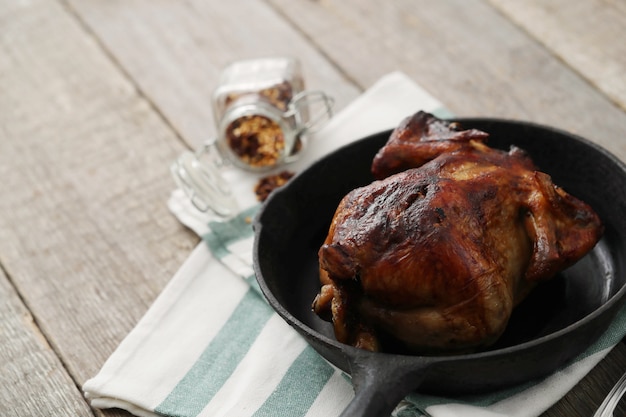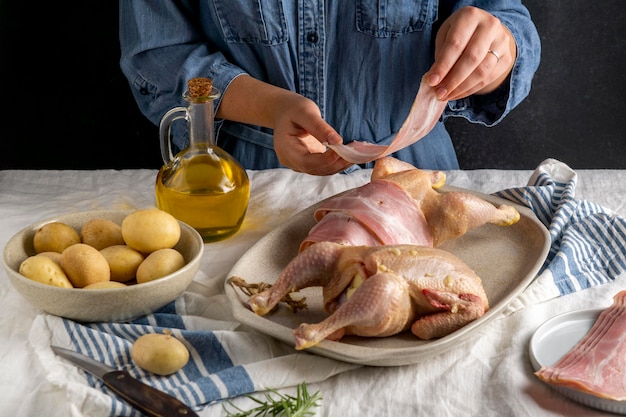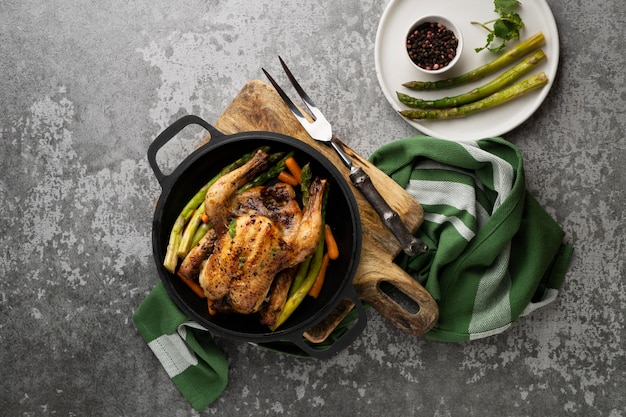Let’s face it, duck can be a bit intimidating. It’s not exactly your everyday roast chicken, is it? But I’m here to tell you that it’s actually not as difficult as it seems. With a little bit of knowledge and a few key tips, you can easily cook a duck that’s crispy on the outside and succulent on the inside, leaving everyone impressed. So, put on your apron, grab a glass of wine, and let’s dive into the world of duck cooking!
(Part 1) Choosing the Right Duck: A Culinary Decision

Your culinary adventure starts with choosing the right duck. You’ll find a variety of options at your butcher or supermarket, each with its own unique character:
Whole Duck: The Classic
This is the granddaddy of all duck options. It’s perfect for a special occasion or a family gathering. The whole duck is a culinary masterpiece, allowing you to roast it to perfection and create a beautiful, juicy feast. Plus, you can turn the carcass into a flavourful stock afterwards!
Duck Breast: The Versatile Choice
If you’re after something a bit more manageable, or you’re cooking for just a couple of people, a duck breast is the way to go. It’s incredibly versatile – you can pan-fry it, grill it, or even roast it. The flavour is intense, and the meat is incredibly tender.
Duck Legs: A Hidden Gem
Don’t dismiss duck legs – they’re seriously delicious! They’re packed with flavour and incredibly succulent, especially when braised or roasted. They’re also ideal for confit.
Duck Breast and Leg Combo: The Best of Both Worlds
This combination offers the perfect balance – the juicy tenderness of the legs and the rich flavour of the breast. It’s a fantastic choice if you want a bit of everything!
No matter what type of duck you choose, make sure it’s fresh. Look for a duck with a shiny, unblemished skin. The skin should be plump and intact, not dry or discolored.
(Part 2) Preparing the Duck: Mastering the Basics

Now that you’ve got your duck, it’s time to get ready for the main event.
Pat Dry, Pat Dry, Pat Dry
This might sound obvious, but it’s crucial for getting that crispy skin. Pat the duck dry with kitchen paper, especially if it’s been in the fridge. The more moisture you can remove, the better the skin will crisp up.
Scoring the Skin: Unlocking Flavor
Scoring the skin is like giving your duck a little massage. It allows the fat to render out, which creates a beautifully crispy texture and enhances the flavour. Use a sharp knife to make shallow diagonal cuts across the skin, about half an inch apart. Be careful not to cut all the way through the meat.
Seasoning: A Symphony of Flavors
This is where you can unleash your creativity! I always start with salt and pepper, but feel free to add your favourite spices. Paprika, chili flakes, garlic powder, herbs, or even a bit of citrus zest – the possibilities are endless. Remember, the more flavour you add, the tastier your duck will be.
(Part 3) Cooking the Duck: The Roast Masterclass

Now comes the fun part. Roasting a whole duck is a truly rewarding experience. The results are spectacular: crispy skin, succulent meat, and a rich, flavorful pan sauce that will have you licking your plate.
Preheating the Oven: Setting the Stage
Start by preheating your oven to a high temperature, around 400°F (200°C). This gives the duck a head start on getting that beautiful golden-brown crisp.
Roasting: A Culinary Ballet
Place the duck in a roasting pan, breast side up. Make sure the pan is large enough to accommodate the duck comfortably. If you're feeling adventurous, stuff the cavity with herbs and aromatics, like rosemary, thyme, bay leaves, or even some garlic cloves.
Roast the duck for about 30 minutes, basting it regularly with the fat that renders out. After 30 minutes, reduce the oven temperature to 350°F (175°C) and continue roasting for another 30-45 minutes, or until the duck is cooked through and the skin is perfectly crispy. Don’t forget to keep basting!
Resting: A Moment of Patience
Once the duck is cooked, remove it from the oven and let it rest for 10-15 minutes before carving. This allows the juices to redistribute, resulting in incredibly tender and flavorful meat.
(Part 4) Cooking the Duck: Pan-Frying Perfection
For a quicker and easier option, pan-frying is a great choice, especially for duck breasts. It’s perfect for a smaller group or when you want a simple yet satisfying meal.
Preheating the Pan: A Hot Start
Heat a heavy-bottomed skillet over medium-high heat. You want the pan to be nice and hot. You’ll know it’s ready when a drop of water sizzles instantly on the surface.
Cooking: Crispy Skin, Tender Meat
Place the duck breast in the hot pan, skin side down. Let it cook undisturbed for about 5-7 minutes, or until the skin is nicely browned and crispy. Don’t be tempted to move it around too much, let it get that beautiful golden-brown crust.
Once the skin is beautifully browned, flip the duck breast and cook for 3-4 minutes on the other side. Use a meat thermometer to ensure it’s cooked to your liking – medium-rare is usually around 135°F (57°C). If you prefer it more well-done, cook it a little longer.
Resting: A Well-Deserved Break
Finally, let the duck breast rest for 5-10 minutes before slicing. This allows the juices to settle, resulting in a more tender and flavourful dish.
(Part 5) Cooking the Duck: The Art of Confit
Confit is a culinary marvel, a slow-cooking technique that transforms duck legs into a tender, melt-in-your-mouth delicacy. It’s a bit of a love affair with your duck, a slow and gentle process that yields incredibly rewarding results.
Preparing the Duck: Getting Ready for the Bath
Trim any excess skin off the duck legs, leaving the skin intact. Season the legs generously with salt and pepper. Add your favourite spices, herbs, or even a bit of orange zest – a sprinkle of garlic powder goes a long way.
Simmering in Fat: A Slow and Gentle Cuddle
Place the duck legs in a heavy-bottomed pot, skin side up. Add enough duck fat to completely cover the legs. If you don’t have duck fat, use a mix of olive oil and butter. Goose fat is a luxurious alternative that imparts a richer flavour.
Bring the fat to a gentle simmer over low heat. This is a crucial step. You want to simmer the legs slowly and gently, allowing the fat to melt and slowly surround the duck. It’s all about patience.
Simmer the duck legs for 2-3 hours, or until the meat is incredibly tender and falls off the bone. Make sure the legs are submerged in the fat throughout the cooking process. It's a bit like slow cooking, a long and gentle process that rewards you with a truly divine result.
Serving: A Culinary Triumph
Once the duck legs are cooked, remove them from the pot and let them cool slightly. You can use the rendered fat for cooking other things – it’s flavourful and delicious! You can serve the duck legs warm, at room temperature, or even cold. I personally love them chilled, making them perfect for picnics or charcuterie boards. They also go beautifully with a simple salad or creamy mashed potatoes.
(Part 6) Duck Pan Sauce: The Perfect Accompaniment
No duck dish is complete without a rich and flavorful pan sauce. It's the final touch, the cherry on top, that elevates your dish to a whole new level.
Making the Sauce: Liquid Gold
Once you’ve cooked your duck, you’ll have a pan full of delicious duck fat and juices. Don’t discard it! It’s liquid gold! Add a splash of red wine or high-quality stock (chicken stock works wonders) to the pan and bring it to a simmer. Scrape the bottom of the pan to release all those tasty bits. You can also add a little Dijon mustard, honey, or a squeeze of lemon juice for extra zing.
Simmer the sauce until it reduces and thickens slightly. Then, strain it through a fine-mesh sieve to remove any solids. Your pan sauce should be silky smooth, with a beautiful rich colour.
Serving: A Symphony of Flavors
Serve the pan sauce over your duck, or use it to create a delicious gravy. It’s incredible with roast vegetables, mashed potatoes, or even a simple bed of rice.
(Part 7) Sides for Duck: Completing the Feast
What will you serve your duck with? Here are a few of my favourite sides:
Roast Vegetables: A Colorful Harmony
Root vegetables like carrots, parsnips, and potatoes are classic companions for duck. But don’t be afraid to experiment with seasonal vegetables like asparagus, broccoli, or Brussel sprouts. Roast them with a little olive oil, salt, pepper, and herbs for a flavourful symphony of tastes.
Mashed Potatoes: A Creamy Delight
A creamy mash is always a crowd-pleaser and goes beautifully with duck. Try making mashed sweet potatoes for a touch of sweetness and a vibrant colour.
Quinoa or Rice: A Lighter Option
For a lighter accompaniment, quinoa or rice is a great choice. Add a little chopped parsley or coriander for extra flavour.
Green Salad: A Refreshing Contrast
A simple green salad with a vinaigrette dressing adds a refreshing touch of acidity to a rich duck dish. It’s the perfect counterpoint, creating a wonderful balance of flavours.
(Part 8) Serving and Enjoying Your Duck: A Culinary Celebration
You’ve done it – you’ve cooked an incredible duck! Now it’s time to enjoy it.
Carving: A Skillful Touch
Carve your roast duck using a sharp knife. The meat should come off easily, and you can use the duck bones to make a flavorful stock afterwards. Serve it with a rich pan sauce, a testament to your culinary prowess.
Presentation: A Feast for the Eyes
For a truly stunning presentation, arrange the carved duck meat on a platter with a bed of roast vegetables, mashed potatoes, or quinoa. Garnish it with a sprig of parsley, a drizzle of pan sauce, and a squeeze of lemon juice. It’s a feast for both the eyes and the palate.
Wine Pairing: A Perfect Harmony
A good red wine is a perfect companion for duck. I love a full-bodied Cabernet Sauvignon, Pinot Noir, or even a Syrah. But a light-bodied red like Beaujolais or a dry white wine like Sauvignon Blanc can also be fantastic pairings.
(Part 9) duck leftovers: A Culinary Treasure
Leftovers are a culinary treasure, a chance to enjoy the delicious flavours of your duck for days to come.
Storing: Preserving the Magic
Store any leftover duck in the fridge, covered with cling film. It’s best to eat it within a day or two.
Using Leftovers: Creative Culinary Adventures
Here are a few ideas for using your leftover duck:
- Slice the duck and add it to a salad or sandwich for a delicious lunch.
- Serve the duck with pasta and a creamy sauce, or with rice and vegetables.
- Make a delicious duck soup or stew, transforming your leftovers into a comforting meal.
(Part 10) FAQs: Solving Culinary Mysteries
You’ve cooked an amazing duck. Now it’s time to answer some of those lingering questions.
Q: How do I know if the duck is cooked through?
A: You can use a meat thermometer to check the duck’s internal temperature. It should reach 165°F (74°C) for the breast and 170°F (77°C) for the legs. You can also tell if the duck is cooked by pricking it with a knife. The juices should run clear, not pink.
Q: What if the skin doesn’t get crispy?
A: Don’t fret! Here are a few tips:
- Pat the duck dry very well before cooking.
- Score the skin deeply, allowing the fat to render out properly.
- Cook the duck at a high temperature, and don’t overcrowd the pan.
Q: Can I cook a duck in a slow cooker?
A: Absolutely! It’s a great way to make duck legs tender and juicy. But you won’t get the same crispy skin.
Q: How can I get rid of the duck smell?
A: A few simple tricks will help:
- Wash your hands thoroughly with soap and water after handling the duck.
- Wipe down your work surfaces with a disinfectant.
- Boil a pot of water with lemon juice or vinegar.
Q: What are some good recipes for duck?
A: The world of duck recipes is vast and delicious! Here are a few of my favorites:
- Roast Duck with Orange and Rosemary – a classic combination of flavours.
- Duck Breast with Cherry Sauce – a touch of sweetness and tartness to balance the richness.
- Duck Confit with Potatoes and green beans – a comforting and elegant dish.
- Duck Breast with Pan-Fried Pears and Walnuts – a perfect balance of sweet and savory.
- Duck Leg Curry – a vibrant and flavorful dish with Indian spices.
Armed with this knowledge, you’re ready to embark on a culinary adventure with duck. Remember, there’s no substitute for a little practice and a touch of confidence. So, go forth and create your own duck masterpieces!
Everyone is watching

Prime Rib Roast Cooking Time Chart: Per Pound Guide
Cooking TipsPrime rib roast. Just the name conjures images of lavish dinners, crackling fires, and hearty laughter. It’s ...

How Long to Bake Potatoes in the Oven (Perfect Every Time)
Cooking TipsBaked potatoes are a staple in my kitchen. They're incredibly versatile, delicious, and surprisingly easy to m...

Perfect Rice Every Time: The Ultimate Guide to Cooking Rice
Cooking TipsAs a self-proclaimed foodie, I've always been a bit obsessed with rice. It's the foundation of countless cuisi...

The Ultimate Guide to Cooking Asparagus: Tips, Techniques, and Recipes
Cooking TipsAsparagus. The mere mention of this spring delicacy conjures up images of vibrant green spears, crisp and burs...

Ultimate Guide to Cooking the Perfect Thanksgiving Turkey
Cooking TipsThanksgiving. Just the word conjures up images of overflowing tables laden with delicious food, the scent of r...
